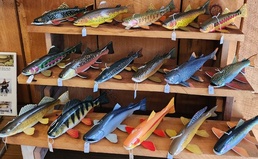The cougar controversy
Feb. 15, 2009
The cougar controversyAnne Stanton 2/16/09
At 4 a.m. on January 31, Dan Kaizer was at the tail-end of his newspaper route, driving his Chevy Silverado on South Betsie Road near Bendon in Benzie County.
About 100 yards down the road, he saw something walking slowly across the road. He was doing 45 mph, so he gained on the creature quickly. As he slowed down a bit, he figured it was some kind of cat.
“When I got up to about 50, 60 yards away in my high beams, I could see it as plain as day. It was a cougar with a long black tail, jet black, it was crouched down in a prey position, slowly walking. I guarantee he was stalking some deer.
“In fact, the cougar had come off a deer trail on one side of the road and jumped up about six feet to the deer trail where it continued on the north side of the road.”
Could he have confused it with a bobcat? After all, lots of people do.
Kaizer laughed. “Wanna come to my house?” Turns out, he has a mounted bobcat—a trophy from an out-of-state hunt.
Kaizer hasn’t told the state Department of Natural Resources (DNR) of his sighting because he considers it a waste of time.
And so it would seem. Without a clear photo showing the woods behind the cat, a photo of the paw print with a ruler next to it, a clear video, a carcass, or a hair sample from the bumper, the DNR doesn’t really want to hear about it. Kaizer’s story also sounds suspect, said one DNR official, because the cougar was black, a species that isn’t even native to this country.
NO EVIDENCE
Area DNR employees, quite frankly, are intensely and deeply skeptical that there are any cougars in Michigan, be it an escaped pet or otherwise. How can it be, they ask, that so many hundreds of people have claimed to see a cougar, and yet there’s been so little evidence?
Area DNR officers have checked out call after call of cougar sightings, only to find out it was a dog or a bobcat—there are lots of bobcats in Northwest Michigan. Every time there’s a news article, there are lots more of these kinds of calls and more dead-ends.
Then there’s the Sleeping Bear National Lakeshore. Signs are posted throughout the park, warning about cougars. About 10 to 15 people each year report they’ve seen a cougar, including a volunteer doing trail surveys.
So how come no one has been able to come up with one photo of a track or a video? a DNR conservation officer asked.
“We did research the one winter in 2004/2005. And we admit we have to do summer surveys,” said Lakeshore Biologist Ken Hyde.
“Cougars are hard to lure in. Baits don’t work real well, nor do scents. The tribes have been doing quite a few track surveys all over the Lower Peninsula, and they have not come up with a good set of cougar tracks. But at least we’re keeping the public informed that this is a possibility, and it would be a great addition to a predator base around Lake Michigan,”
It’s a good question: how come, with the thousands of trail-cams posted in the entire state of Michigan has no one been able to come up with a good video?
Even when there is evidence, the DNR is skeptical. Anyone can draw a paw print in the sand. Anyone can alter a cougar photo with Photoshop. A car bumper with hair on it? Could have been driven in from anywhere. Even when there is a cougar, the DNR says it’s an escaped pet or it wandered in from another state.
WAIT! SOLID EVIDENCE
As it turns out, there has been solid evidence, much of it presented at a state Senate subcommittee meeting just a few days before Kaizer saw his cougar. Veterinarians, scientists, and just plain folks brought forth their evidence and stories of sightings before the Senate Agriculture and Bioeconomy Committee, chaired by Gerald Van Woerkom, a Republican from Muskegon.
“People are so angry at how they’ve been treated by the DNR, this is all going to unravel,” said Dennis Fijalkowski, executive director of the Michigan Wildlife Conservancy, which has been trying to prove the cougar’s existence since it formed in 1982.
“A Democrat in the hearing asked every speaker, ‘How were you treated by the DNR?’ This senator had been getting ugly mail about people being made fools of, and they don’t like it. It’s been going on for 40 years, people being discredited and being made fools of in the press. Our citizens are not frauds, and we’re all sick of being treated this way. Forty years is enough!”
Yet Fijalkowski said that about 100 DNR employees had sighted a cougar, and half of them reported the sightings to his group.
Included in the evidence was a videotape of a cougar and her nearly grown cub in Monroe County. The video was analyzed by a retired Michigan State Police lieutenant, who deemed the video had not been tampered with; but the DNR does not believe the animals are cougars. There have also been numerous scat samples, which were confirmed by the DNR from several sites around the state.
‘CALLED HIM A LIAR’
There was also a photo of a track found nearly a year ago in Delta County (the Upper Peninsula) by Mike Zuidema, a member of the Michigan Wildlife Conservancy. The DNR congratulated Zuidema on diligently preserving the evidence.
“Mike was 34 years with the DNR, and they called him a liar when he reported his first cougar. So he spent the next 29 years trying to find proof, all the while being called Crazy Mike by his colleagues,” Fijalkowski said. “When he found 200 yards of track, he pulled the DNR out there and they just couldn’t deny it.”
Five years ago, a car hit a large cat in Menominee County. Hair was taken off the bumper and a DNA test confirmed that it was, in fact, a cougar. A special team of DNR biologists, sent out West to study the large cats, agreed that the animal was a cougar.
“We have that evidence for a reason and one reason only. The hair was pulled off by a state trooper who was incorruptible and he made the DNR do a test on it. They had to release the information because a state trooper was in the chain of evidence,” Fijalkowski said.
Van Woerkom asked during the hearing why the DNR is so adamant about denying there’s a breeding population in the state.
“When reliable people tell you they saw a cougar with kittens, that’s pretty good evidence,” Van Woerkom was quoted in a Detroit Free Press article. “I’ve been bringing this up with the DNR for three or four years and they just kind of blow it off, saying we have no physical evidence. But that’s not true. We have physical evidence, and it looks like (cougars) stretch from Lake Michigan to Lake Huron.”
Van Woerkom speculated that the underlying reason is money. The agency would have to protect cougars as mandated by the Endangered Species Act.
But area DNR officials—some who declined to be interviewed on the record—compare cougar sightings to seeing a UFO. There is no conspiracy; they simply have not seen any solid evidence collected in this area, although they’ve heard lots of stories.
A BIG CAT
Mary Lapalme, also of Bendon, wasn’t able to collect evidence, but has absolutely no doubt she saw a cougar.
“Mine happened two years ago in the spring. I was coming home from the Interlochen Library, and I take the back roads home. I was on Gonder Road and turned the corner coming onto Rose, and I saw a cat across the road. From where I was, you could see the silhouette of an actual cat. I didn’t think anything of it. But as I drove further along the road, I thought, whoa, this is a big cat. It has to be a bobcat. So I crawled to the stop where it crossed the road, and this cougar was sitting on the edge of the road. We had a 10-minute stare-down. It was just very cool. I was memorizing every aspect of him. The color of his fur, which was brown, the color of deer. He was sitting on his haunches; we were eye to eye level. His head was gi-normous. I turned the car off because I didn’t want to scare him, but there was no way I was going to crack the window. So there I was, sitting in this car, no way to call anybody, no way to take a picture. It was terrible, all this technology and no way to record it.”
Lapalme drove off, leaving the cougar still sitting on the side of the road.
“That’s my story. I went back to the library, and we did a search for cougars on the computer. And that’s what I saw.”
Lapalme, who now has a cell phone with a camera, said she has also seen giant cat tracks in her backyard, which abuts state and federal land. The Bendon area has a huge swamp, populated by large deer herds. If the sightings were indeed correct, there are two cougars in the Bendon area.
SWAMP CATS
Kaizer thinks cougars have lived in the swamp for decades.
“I went to the Bendon Heritage Festival this past summer, and I got to talking to some old timers from around here, and one gentleman who lives near Copemish said he has pictures of a tawny colored cougar in his backyard.”
Kaizer didn’t get the name of the man with the photo.
Veterinarian Jennifer Klabunde of Northwood Animal Hospital said she knows the issue of cougars is controversial, but has no doubt there are cougars in the Bendon area. One client from Bendon brought in a clear and unmistakable photo of two cougars chasing down a deer in broad daylight. The photo was taken down the street from Klabunde’s own veterinary practice, which is in Grawn, about seven miles from Bendon. The landmarks in the photo were undisputable.
“She didn’t give the photo to the DNR for fear they’d just say ‘no.’ Plus it would jut cause chaos and what’s the point of it?” said Klabunde, adding that the woman kept the photo. She was unable to remember her name.
Klabunde recently treated a dog that she believes was attacked by a cougar.
“The space between the canine was massive. The space between the top and the bottom canines was way too huge. It wasn’t a dog or a coyote. And I’ve seen a bite from a bobcat; I know how big they are. There was too much space.”
Klabunde said the skin had been pulled entirely off the dog’s back. She didn’t measure the span of the bite.
The sheltie recovered completely, but died from cancer two months later.
Rich Earle, a wildlife biologist of the Traverse City DNR office, said that a small dog would never have survived a cougar attack. It was more likely an attack by a coyote or bobcat. In fact, most people who believe they saw a cougar actually saw a bobcat or coyote.
Klabunde agreed the kill would have been instantaneous, but the owner interrupted the attack.
“The owner heard some noise, came out, flicked on the light, and scared it off immediately. I agree that otherwise, it would have been dead.”
ONE IN 100...
Earle has been involved with these reports for years. Back in 1995, he received a hair sample from a cougar that was hit by a motorist in Iron County. He said last week, in an Express interview, that a policeman collected some hair off the bumper and gave it to a DNR conservation officer, who sent it to him. Lyle compared it to a hair specimen from a cougar in the Traverse City zoo. He couldn’t do a DNA analysis at the time, because it didn’t contain the root. But the hair samples looked similar. He said the hair sample is now in the DNR archives.
“I could not vouch for the validity of the sample,” Earle said. “The chain of evidence was not present at all. I have no real idea of where it came from.”
But you just said …
Bob Butz, an outdoor writer who lives in Traverse City, said he followed this whole issue for five years for his book on cougars in the United States, titled Beast of Never, Cat of God. He agrees with the DNR that 99 out 100 times people have actually seen something else besides a cougar, but then there’s that 100th time.
He himself saw a cougar in the Houghton Lake area with paws as “big as pies” and a “long-ass f*#! tail.”
Butz did what any good researchers do. He measured the paw prints—the length and width of the track was nearly a perfect four-inch square. Stride length, 26 inches. Pat Rusz of the Michigan Wildlife Conservancy, who was with Butz on the cougar search, went back to his truck to fetch his camera to take photos. By the time he got back to the tracks, the sun had gone down and the flash washed out the detail. A rare chance for evidence had faded with the sunlight.
PHOTOGRAPHING COUGARS
Butz, who is nearly as skeptical as the DNR about cougar sightings, agrees the standard of evidence should be very high. When hiking or in the car, always have a camera with you. If you see a cougar, look immediately for tracks and scat. Lay down a ruler or some object with a known length next to the track for scale. If you don’t have a camera with you, cover the track with a bucket to protect the track. If you take a photo of the cougar, try to include landscape in the background.
There are a few websites that collect evidence and stories of sightings including the Michigan Wildlife Conservancy, savethecougar.org and Michigan Citizens for Cougar Recognition. Sightings of cougars may be reported to the DNR on-line at www.michigan.gov/dnr under Wildlife and Habitat -Wildlife Observations. If you have physical evidence of a cougar (scat, tracks, or carcass), contact your local DNR Operations Service Center.
Yet Kaizer and others are gunshy about calling the DNR about a cougar sighting. He said that if he ever hits a cougar with his car, his first call will be to the media and the Michigan State Police… And then the DNR.
“That’s the only way to bring out the truth. If you fight the DNR, you’ll lose. They think it’s the same as believing in UFOs, so why bother?”
Trending

The Art of the Decoy
On mantles and shelves around the country (and indeed, around the world) sit intricate and beautiful wooden fish decoys that… Read More >>
Wreath the Halls
Get ready for the holidays with the ultimate wreath workshop! Boyne Mountain hosts Wreathfest, Saturday, Nov. 8, with Kalin … Read More >>
TC Beer Week Is Back!
Traverse City will be getting sudsy this weekend, as Traverse City Beer Week returns Nov. 7-15. This year, each day has a th… Read More >>


